Toe beans typically come in sets of 4 per paw! Toe beans don’t directly relate to paw shape, though they are a part of it! Before we talk about paw shape, let’s start with this:
If you were to compare a human hand and a dog’s front foot you’d find loads of similarities in the bones and structure. (Where the image below was found).
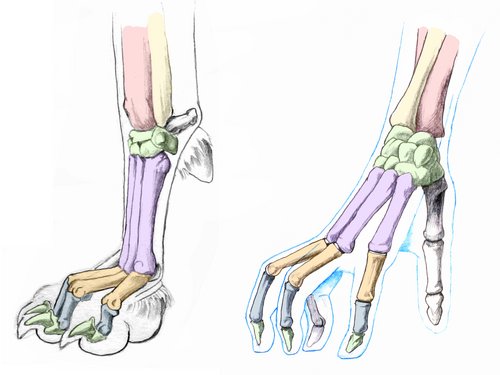
WHOAH! Wrist bones, assorted finger bones and… thumbs! See that funky little “thumb” bone on the dog’s foot? That’s a dew claw! Thoughts are dew claws are the remnants of prehistoric evolutionary thumbs! Quite nifty!
Even though our hand structures and dog paw structures are similar, we differ in how we walk upon the ground. Humans are plantigrades, meaning we walk with our toes and metatarsals flat on the ground. We share this trait with some primates, bears, skunks, raccoons, weasels, badgers, otters, red pandas, mice, rats, porcupines, rabbits, hedgehogs, hyraxes, kangaroos, opossums, loons & grebes. (Most early primitive mammals were plantigrade, digitigrade and unguligrade modes of movement evolved later.)
Dog walk on their fingertips and toes, which means they are digitigrades! Joined with them as digitgrades are birds, cats, big cats, hyenas, mongoose, wild dogs, coyotes, wolves, and foxes. (There are semi-digitgrades too! Pigs, peccaries, hippopotamus, elephants and capybara are all semi-digitgrade!)
Additionally, dog feet come in 3 main shapes – hare feet, cat feet and webbed feet.
Hare foot paws have extended 2nd and 3rd digits making the foot longer (similar shape to the feet of a rabbit or hare). Typically thought to be an advantage in running and speed, it also may be an indicator of a similar ancestor of the past, as Chesapeake Bay Retrievers and Bedlington Terriers aren’t heavily noted for their speed and have hare feet noted in their AKC standards!
Cat foot paws are neat round paws with the toe beans nestled snugly together. This gives the toes a high arch and stance similar to the paws of a cat. The shape lends to greater endurance over speed, or so its thought. (Toy dogs don’t strike me as the endurance type… though with short legs they may have needed paws that could match their master’s stride…). To note – there are more breeds with cat foot paws than hare foot paws!
Webbed feet are found in all dogs (webbing refers to the membranes between the toes) though some dogs have much more pronounced webbing, as noted by their AKC standards. Webbed feet lend towards stronger swimming skills as well as digging skills! Note: all dog have webbed feet – some just more than others!
Those three aside, AKC standards also note: neither cat nor hare foot (or halfway between), round or rounded and oval or slightly oval shapes. Round paws are found in 56 different breeds while oval shaped paws are found in 29 different breeds. There are a few breeds with no noted shape of paws (mostly mentioning toes & their arch) and some breeds with some really funky paws.
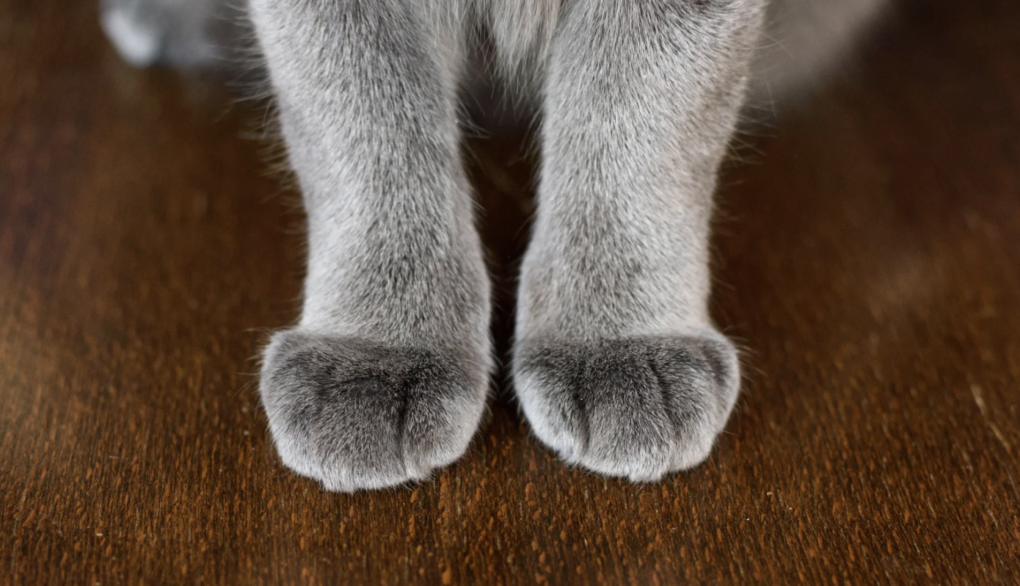
Literally cat feet… this is what a cat foot paw on a dog resembles!
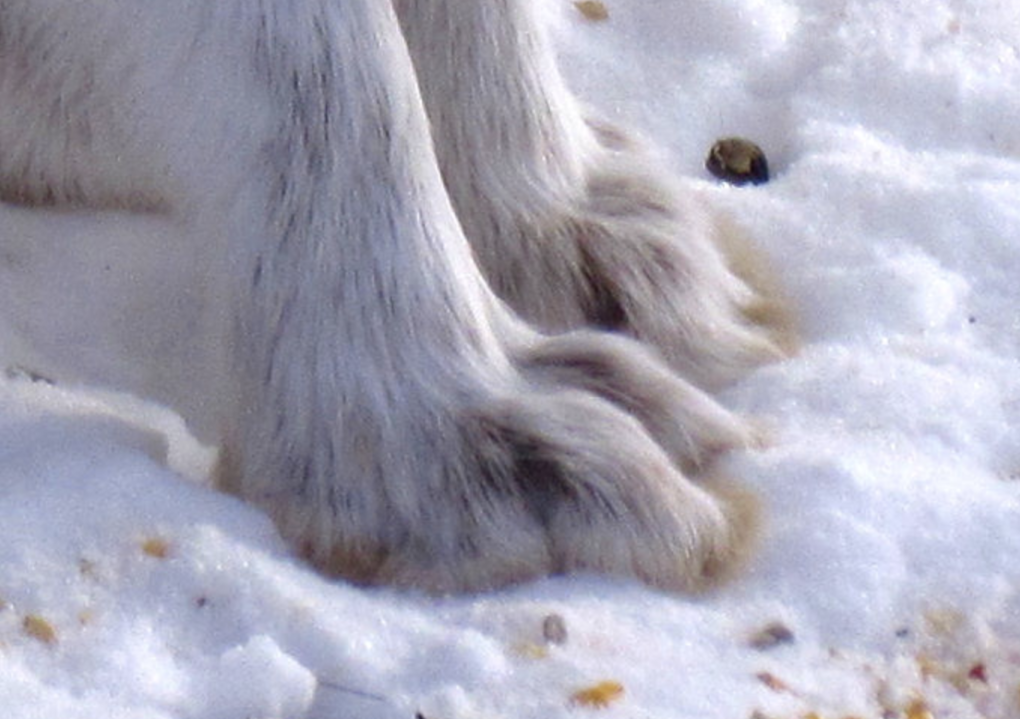
Snowshoe hare feet… this is what a hair foot paw shape should look like.
Before we gander at all the breeds, I have a theory.
Perhaps the natural foot shape, as gained from ancient ancestor dogs and wolves is… a round or slightly oval foot shape. Modern wolves leave prints that are nearly equal as wide as they are long, lending to a round or slightly oval shape. Looking into the ancestry of dogs, the proto-dog / ancestor wolf prints alongside the child’s footprint in the Chauvet Cave in France are rounded as are the ancient paw prints in the Grotta della Bàsura cave system in Italy.
African wild dogs, maned wolves, coyotes, foxes, jackals, and hyenas all have rounded or slightly oval feet as well. The Azawakh breed is exceptionally fast and has rounded feet…
Perhaps in some lineage there was a genetic funk that lent towards long middle toes (this article from 1857 talks about different common greyhound types). Really fast dogs were bred with other fast dogs to create further fast dogs, not always aligned to the greyhound breed in itself. (Remember, many modern breeds were refined to the types and standards in the late 1880s when dog shows became vogue.)
Merely a wild theory. I digress… onward to what you want to know – what breeds have what type of paws?

Breeds with hare foot paws as noted in their AKC breed standard:
-
- Tibetan spaniel
- Chinese crested
- Italian greyhound
- Japanese Chin
- Papillon
- Borzoi
- Greyhound
- Ibizan hound
- Sloughi (can also be elongated oval)
- Whippet (more hare than cat, both acceptable)
- Bedlington terrier
- Skye Terrier
- Samoyed
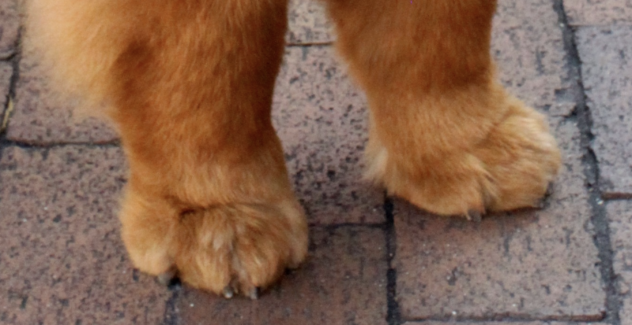
Breeds with cat foot paws (round with arched toes):
-
- Bichon
- Chow
- Keeshond
- Lhasa
- Shiba inu
- Miniature Pinscher
- Pomeranian
- Silky terrier
- Belgian malinois
- Belgian sheepdog
- Belgian tervuren
- Canaan dog
- American English Coonhound
- Bluetick coonhound
- English Foxhound
- Harrier
- Redbone Coonhound
- Treeing Walker Coonhound
- Australian terrier
- Bull terrier
- Miniature Bull Terrier
- Miniature Schnauzer
- Parson Russell Terrier
- Welsh Terrier
- Gordon Setter
- English Cocker spaniel
- Vizsla
- Wirehaired Vizsla
- Akita
- Cane Corso
- Doberman pinscher
- Dogo Argentino
- German Pinscher
- Kuvasz
- Leonberger
- Standard Schnauzer
- Tibetan Mastiff

Breeds with webbed feet (with variable foot shapes noted):
-
- Newfoundland (cat feet)
- Xoloitzcuintli (hare feet)
- Otterhound
- Lagotto Romagnolo (slightly rounded)
- German Wirehair Pointer (round)
- Chesapeake Bay Retriever (hare feet)
- Nova Scotia Duck Tolling Retriever (slightly oval)
- American Water Spaniel
- Boykin spaniel (round)
- Field Spaniel (round)
- Weimaraner
- Wirehair pointing griffon (round)
- Chinook (oval)
- Portuguese water dog (round)
Neither cat or hare foot or halfway between:
-
- Pug
- Chihuahua
- Petit Basset Griffon Vendeen
- Pharaoh Hound
- Brittany
Breeds with round & rounded feet:
-
- Boston Terrier
- Coton de Tuler
- Dalmatian
- Finnish spitz
- Schipperke
- Affenpinscher
- Biewer terrier
- Brussels griffon
- Maltese
- Yorkshire terrier
- Australian cattle dog
- Beauceron
- Bouvier des flandres
- Briard
- Cardigan welsh corgi
- Entlebucher Mountain Dog
- Old English Sheepdog
- Puli
- Spanish water dog
- Azawakh
- Basset hound
- Beagle
- Irish wolfhound
- Rhodesian Ridgeback
- Airedale terrier
- Dandie Dinmont Terrier
- Smooth fox terrier
- Wire fox terrier
- Glen of Imal Terrier
- Irish Terrier
- Kerry Blue Terrier
- Lakeland Terrier
- Norfolk Terrier
- Norwich Terrier
- Scottish Terrier
- Sealyham Terrier
- Soft Coated Wheaten Terrier
- West Highland White Terrier
- German Shorthair Pointer
- Curly Coated Retriever
- Golden Retriever
- Cocker spaniel
- English Springer Spaniel
- Sussex spaniel
- Welsh Springer Spaniel
- Spinone Italianio
- Bernese Mountain Dog
- Black Russian Terrier
- Boerboel
- Bullmastiff
- Great Dane
- Great Pyrenees
- Greater Swiss Mountain Dog
- Mastiff
- Neapolitan Mastiff
- Rottweiler
Breeds with oval or slightly oval:
-
- American Eskimo
- Poodle
- Russian toy
- Toy fox terrier
- Australian shepherd
- Bearded collie
- Bergamasco
- Border collie
- Collie
- Finnish lapphund
- Icelandic sheepdog
- Norwegian buhund
- Pembroke welsh corgi
- Polish lowland sheepdog
- Pyrenean shepherd
- Shetland sheepdog
- Swedish Vallhund
- Basenji
- Cirneco Dell-Etna
- Norwegian Elkhound
- Portuguese Podengo Pequeno
- American Hairless terrier
- Rat Terrier
- Russell Terrier
- Nederlandse Kooikerhonji
- Pointer
- Flat Coated Retriever (oval or round)
- Anatolian Shepherd dog
- Siberian Husky
Breeds with no notable foot shapes:
-
- Bulldog
- Shar-pei
- French bulldog
- Lowchen (middle toes slightly in advance of outer toes)
- Havanese
- Manchester terrier (middle toes slightly longer than others)
- Pekinese
- Shih tzu
- German shepherd dog
- Afghan hound
- Black and tan coonhound
- Bloodhound
- Plott
- Saluki (not cat-footed)
- Scottish deerhound
- American Staffordshire Terrier
- Border Terrier
- Cairn Terrier
- Cesky terrier
- Manchester Terrier
- Staffordshire Bull Terrier
- Labrador Retriever
- English Setter
- Irish setter
- Irish Red & White Setter
- Clumber spaniel
- Irish Water Spaniel
- Boxer
- Dogue de Bordeaux
- Giant Schnauzer
- Komondor
- Saint Bernard

Really unique feet:
-
- English toy spaniel (fused toes often seen and acceptable)
- American Foxhound (feet foxlike)
- Dachshund (five toes, four in use!)
- Alaskan malamute (snowshoe type)
- Tibetan terrier (snowshoe type)
The most unique feet go to….Norwegian lundehund! The feet are oval with at least six fully developed toes, five of which should reach the ground. Eight pads on each foot. The additional toes consist of one three jointed toe, like a thumb, and one two-jointed toe along with corresponding tendons and muscles that give the foot a strong appearance! This unique foot design has a practical use – Norwegian lundehunds were used for hunting puffins and needed to be nimble as they crawled & climbed over rocky outcroppings and cliffs where puffins live.

WHEW! All those feet on all those different dogs!
How about Blue’s big mitts to wrap things up? In measuring he has feet that are roughly 3.5 inches long and 3.5 inches wide – WOLF sized feet! (Wolves typically have feet that are 3 to 4 inches wide and 3-4 inches long though some can have larger). He has dainty white socks, two black toenails (one on a white paw!) and one mostly brown toe.
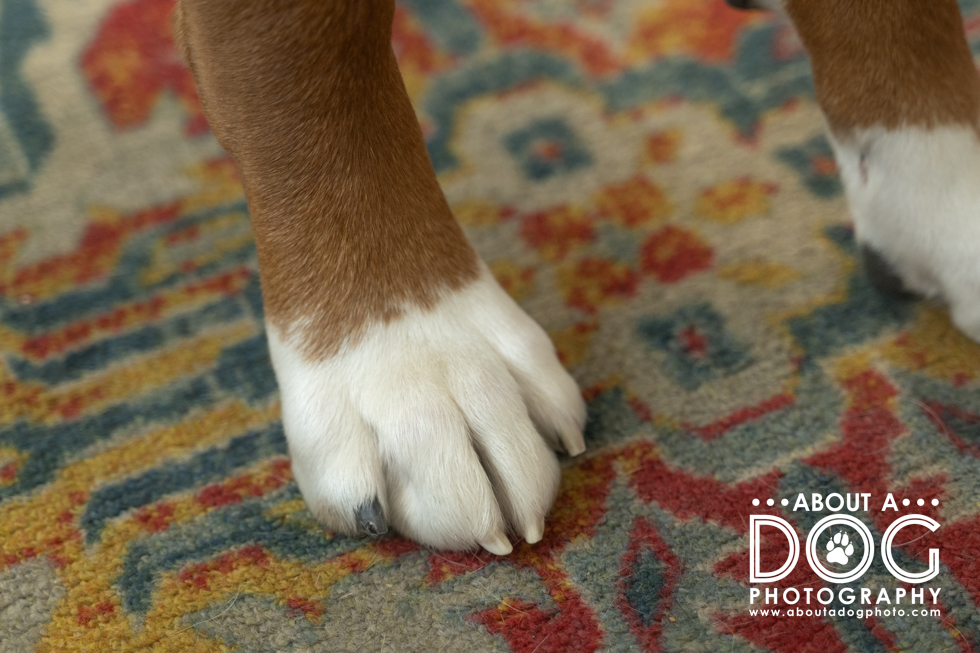
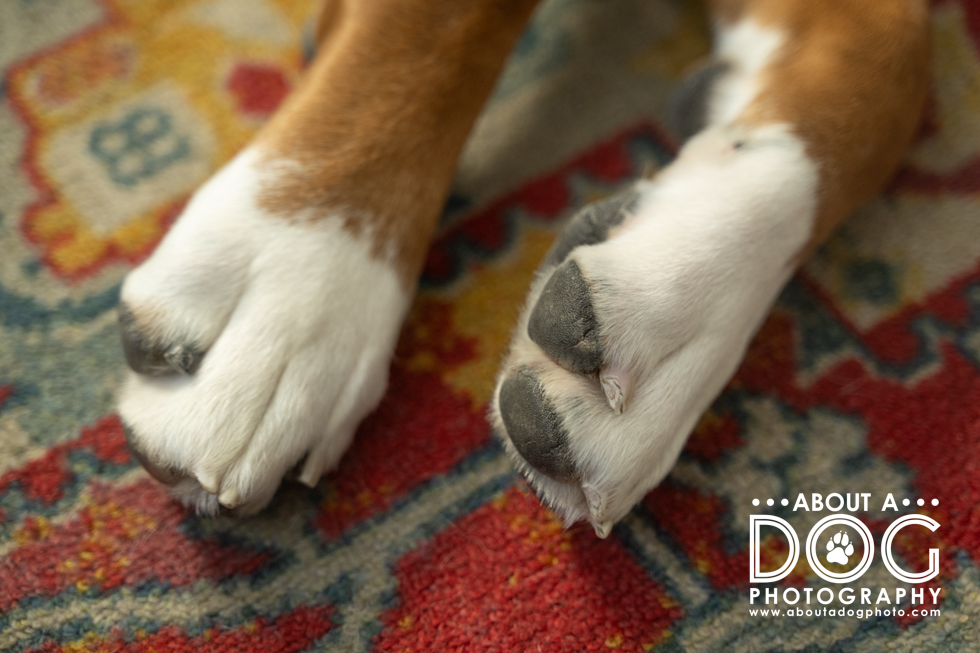
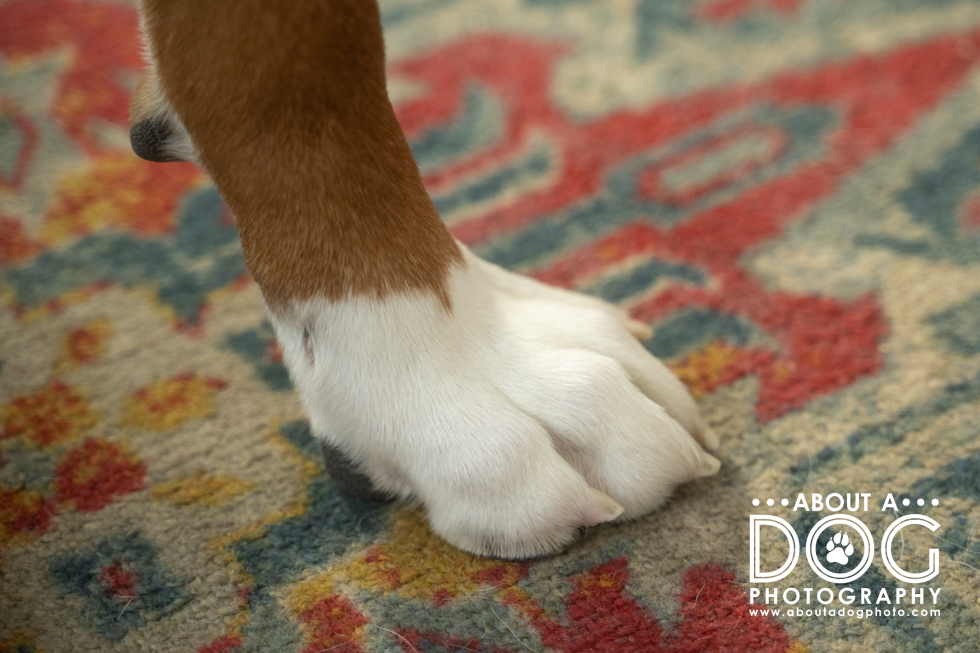
With his feet measuring roughly the same size width and length wise puts him in the appropriate round / rounded foot category!
Such a transition into feet from adorable toe beans (which on Blue are the BIGGEST beans I’ve seen!) into how dog’s feet are like our hands, how dogs are digitigrade and walk on their toes to the different types of paw shapes for different breeds!
What shape of paws does your dog have?
(Images aside from Blue’s big paws were found in various places via Google searches. They are used merely for example purposes. )

I am bookmarking this one for sure. Great information about breeds, paws, and toes!
Who knew there were so many different types of paws? I think my dog would like to think she has cat paws, since she acts like a cat, but her paws and toe beans say otherwise.
Omgoodness this is such a great post! I never knew dogs could have cat paws ::mind blown:: I didn’t see Catahoula on your list but I know mind have webbed feet. I should look into what their shapes are considered! They do have unique toe beans because they’re pink and black!
It was great to read about paw shapes. I am trying to figure out what toe beans my dogs have.
Oh my! Who knew about all of these paw shapes? Hare feet? Thanks for sharing this info, Cahlean! This post gives a whole new meaning to “toe beans” at a new level!!! I learned something new about huskies and where their paws fit in with “oval/slightly oval”. Adorable pics!
Wow I just learned so much!! Moose’s paws were cat shaped and I loved them. Our dogs now have paws that are shaped more like hare paws.